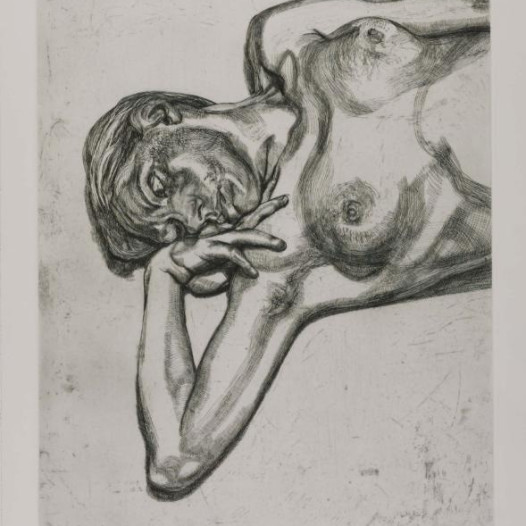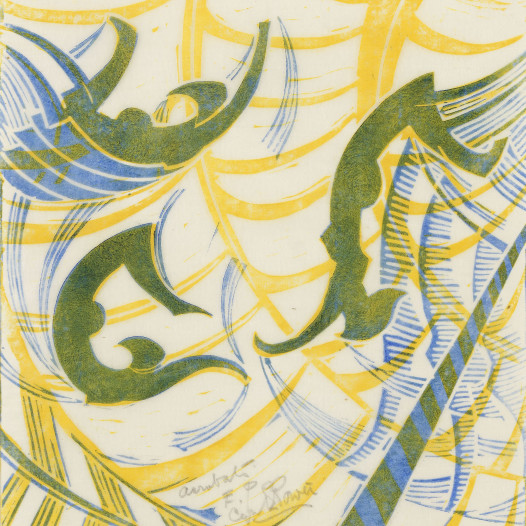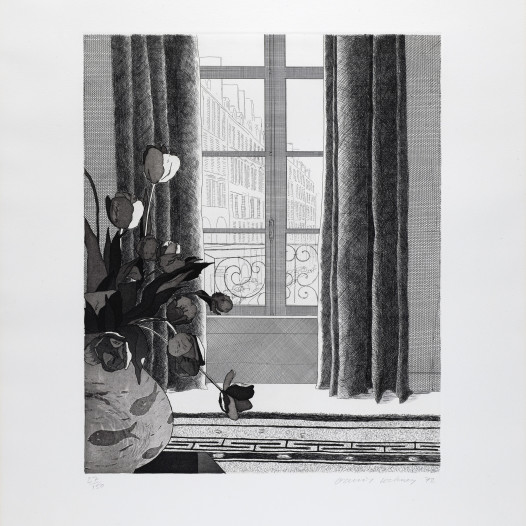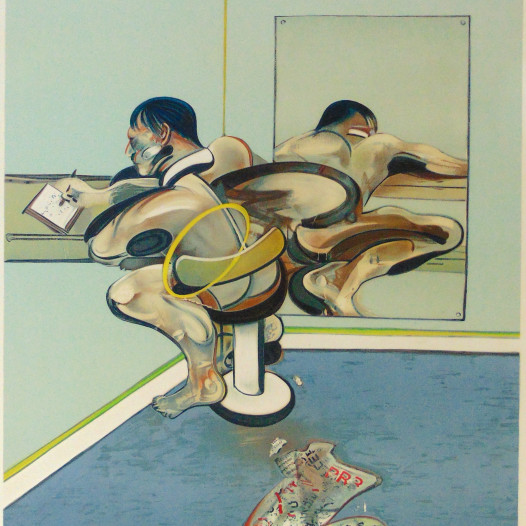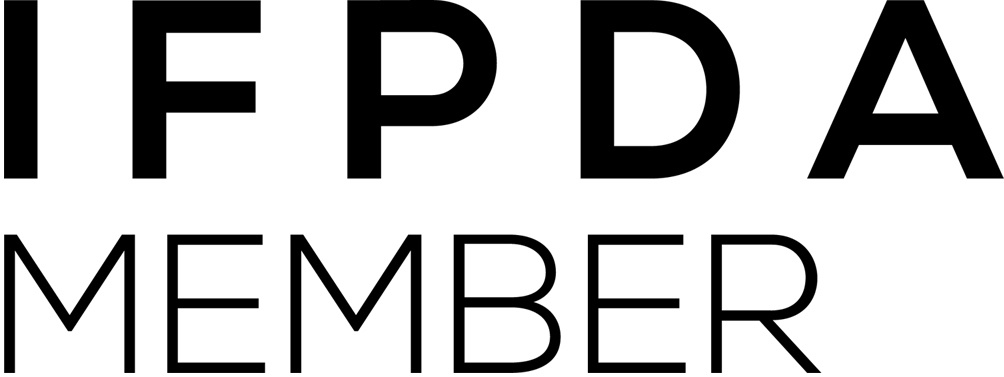Claude Flight
1881–1955Born in 1881, and having worked as an engineer, librarian, farmer and bee-keeper, in 1912 Claude Flight started studying at Heatherley’s School of Art. Claude Flight came late to the art world, but he was to have a significant and long-lasting impact on his contemporaries. He specialised in linocuts, but also illustrated, painted, and made woodcuts. His linocuts are characterised by bold, sweeping lines and bright, overlaid colours. His subjects were those chosen by most of the Grosvenor School—depictions of the heady speed of urban life in between the wars, of transport, and of sport.
Whilst studying at Heatherley’s, Claude Flight met C.R.W. Nevinson, who was a vocal supporter of Futurism, a movement that had a strong influence on Flight’s own work (as well as Vorticism and Cubism). His study was interrupted by the war, during which Flight joined the Royal Army Service Corps as a farrier. He was awarded the Mérit Agricole in acknowledgement of his services to France, and bought a cave in Chantemesle. In 1915 he married a fellow-student, Clare James, with whom he had two daughters. He returned to Heatherley’s when peace was declared, first exhibiting at the Royal Academy in 1921, where he showed some of his first linocuts (with Paris subjects). The following year, he showed with the Seven and Five Society alongside Ben Nicholson, Henry Moore, and Barbara Hepworth. He was later edged out by Nicholson, who became its chairman in 1926, and insisted on strict abstraction from 1934. From 1926-7, Flight edited the periodical 'The Arts and Crafts Quarterly', and in 1928 he joined the Grubb Group as one of its founding members.
In 1922, he began a romantic and working relationship with fellow linocut artist Edith Lawrence, which was to last until his death. They set up an interior decoration business together in 1927, and in the following year they shared an exhibition at the Redfern Gallery.
Flight’s association with the Scottish artist Ian Mcnab led to his joining the staff at the Grosvenor School, in 1926, where he taught linocutting. He championed this cheap, unpopular technique as a way to democratise the process of creating and selling art, and found converts in Cyril Power and Lill Tschudi, among others. His influence (and a lecture, attended by Redfern's co-director, Knyvett Lee, at the Grosvenor School) led to the First Exhibition of British Lino-Cuts at the Redfern Gallery in 1929, which preceded a number of similar exhibitions at the Redfern, as well as some that toured to the provinces and abroad. The initial exhibition was very well received, and led to prints being purchased by the British Museum and the V&A. However, by the outbreak of the Second World War, interest in the work of the Grosvenor School had significantly diminished, and the linocut artists had gone their own separate ways. The end of the movement was marked in 1939 by a show of 148 prints at the Birmingham Art Gallery.
Having left the Grosvenor School in 1930, Flight moved to Wiltshire with Lawrence, but in 1947 suffered a serious stroke, which ended his career. He was looked after by her until his death in 1955.
Works
-
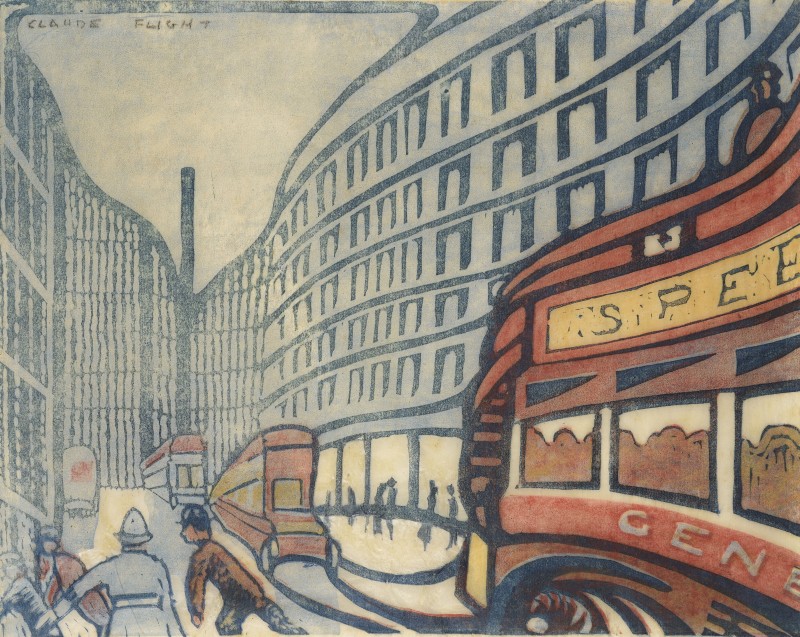 Claude FlightSpeed, c.1922Linocut22.6 x 28.8 cmAn artist's proof, aside the standard edition of 50 impressionsSigned upper left%3Cdiv%20class%3D%22artist%22%3E%3Cspan%20class%3D%22artist%22%3E%3Cstrong%3EClaude%20Flight%3C/strong%3E%3C/span%3E%3C/div%3E%0D%3Cdiv%20class%3D%22title%22%3E%3Cem%3ESpeed%3C/em%3E%2C%20c.1922%3C/div%3E%0D%3Cdiv%20class%3D%22signed_and_dated%22%3ESigned%20upper%20left%3C/div%3E%0D%3Cdiv%20class%3D%22medium%22%3ELinocut%3C/div%3E%0D%3Cdiv%20class%3D%22dimensions%22%3E22.6%20x%2028.8%20cm%3C/div%3E%0D%3Cdiv%20class%3D%22edition_details%22%3EAn%20artist%27s%20proof%2C%20aside%20the%20standard%20edition%20of%2050%20impressions%3C/div%3E
Claude FlightSpeed, c.1922Linocut22.6 x 28.8 cmAn artist's proof, aside the standard edition of 50 impressionsSigned upper left%3Cdiv%20class%3D%22artist%22%3E%3Cspan%20class%3D%22artist%22%3E%3Cstrong%3EClaude%20Flight%3C/strong%3E%3C/span%3E%3C/div%3E%0D%3Cdiv%20class%3D%22title%22%3E%3Cem%3ESpeed%3C/em%3E%2C%20c.1922%3C/div%3E%0D%3Cdiv%20class%3D%22signed_and_dated%22%3ESigned%20upper%20left%3C/div%3E%0D%3Cdiv%20class%3D%22medium%22%3ELinocut%3C/div%3E%0D%3Cdiv%20class%3D%22dimensions%22%3E22.6%20x%2028.8%20cm%3C/div%3E%0D%3Cdiv%20class%3D%22edition_details%22%3EAn%20artist%27s%20proof%2C%20aside%20the%20standard%20edition%20of%2050%20impressions%3C/div%3E -
 Claude FlightLand's End, 1936Linocut29.2 x 35.3 cmFrom the edition of 50 impressionsSigned lower left and numbered lower right%3Cdiv%20class%3D%22artist%22%3E%3Cspan%20class%3D%22artist%22%3E%3Cstrong%3EClaude%20Flight%3C/strong%3E%3C/span%3E%3C/div%3E%0D%3Cdiv%20class%3D%22title%22%3E%3Cem%3ELand%27s%20End%3C/em%3E%2C%201936%3C/div%3E%0D%3Cdiv%20class%3D%22signed_and_dated%22%3ESigned%20lower%20left%20and%20numbered%20lower%20right%3C/div%3E%0D%3Cdiv%20class%3D%22medium%22%3ELinocut%3C/div%3E%0D%3Cdiv%20class%3D%22dimensions%22%3E29.2%20x%2035.3%20cm%3C/div%3E%0D%3Cdiv%20class%3D%22edition_details%22%3EFrom%20the%20edition%20of%2050%20impressions%3C/div%3E
Claude FlightLand's End, 1936Linocut29.2 x 35.3 cmFrom the edition of 50 impressionsSigned lower left and numbered lower right%3Cdiv%20class%3D%22artist%22%3E%3Cspan%20class%3D%22artist%22%3E%3Cstrong%3EClaude%20Flight%3C/strong%3E%3C/span%3E%3C/div%3E%0D%3Cdiv%20class%3D%22title%22%3E%3Cem%3ELand%27s%20End%3C/em%3E%2C%201936%3C/div%3E%0D%3Cdiv%20class%3D%22signed_and_dated%22%3ESigned%20lower%20left%20and%20numbered%20lower%20right%3C/div%3E%0D%3Cdiv%20class%3D%22medium%22%3ELinocut%3C/div%3E%0D%3Cdiv%20class%3D%22dimensions%22%3E29.2%20x%2035.3%20cm%3C/div%3E%0D%3Cdiv%20class%3D%22edition_details%22%3EFrom%20the%20edition%20of%2050%20impressions%3C/div%3E
